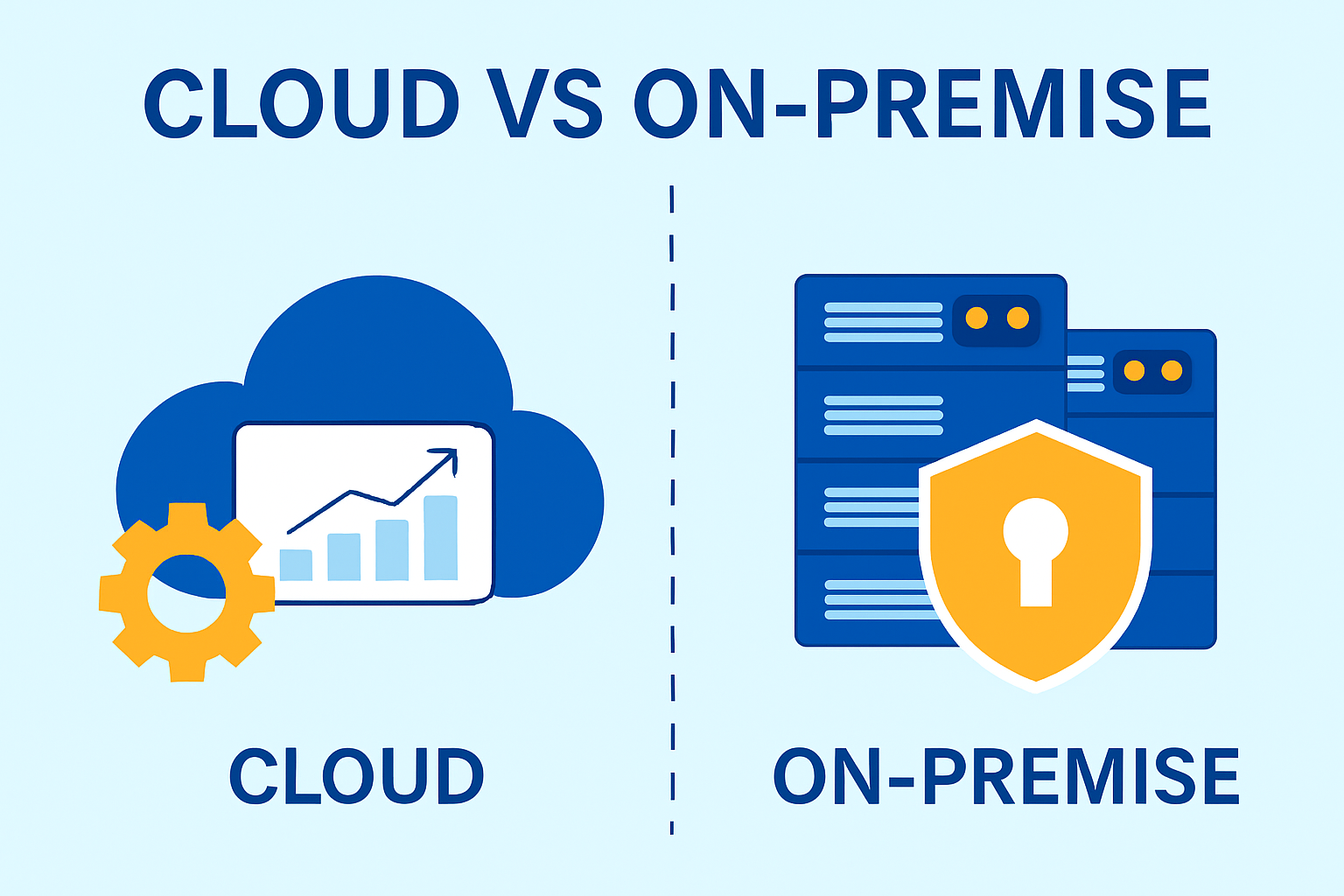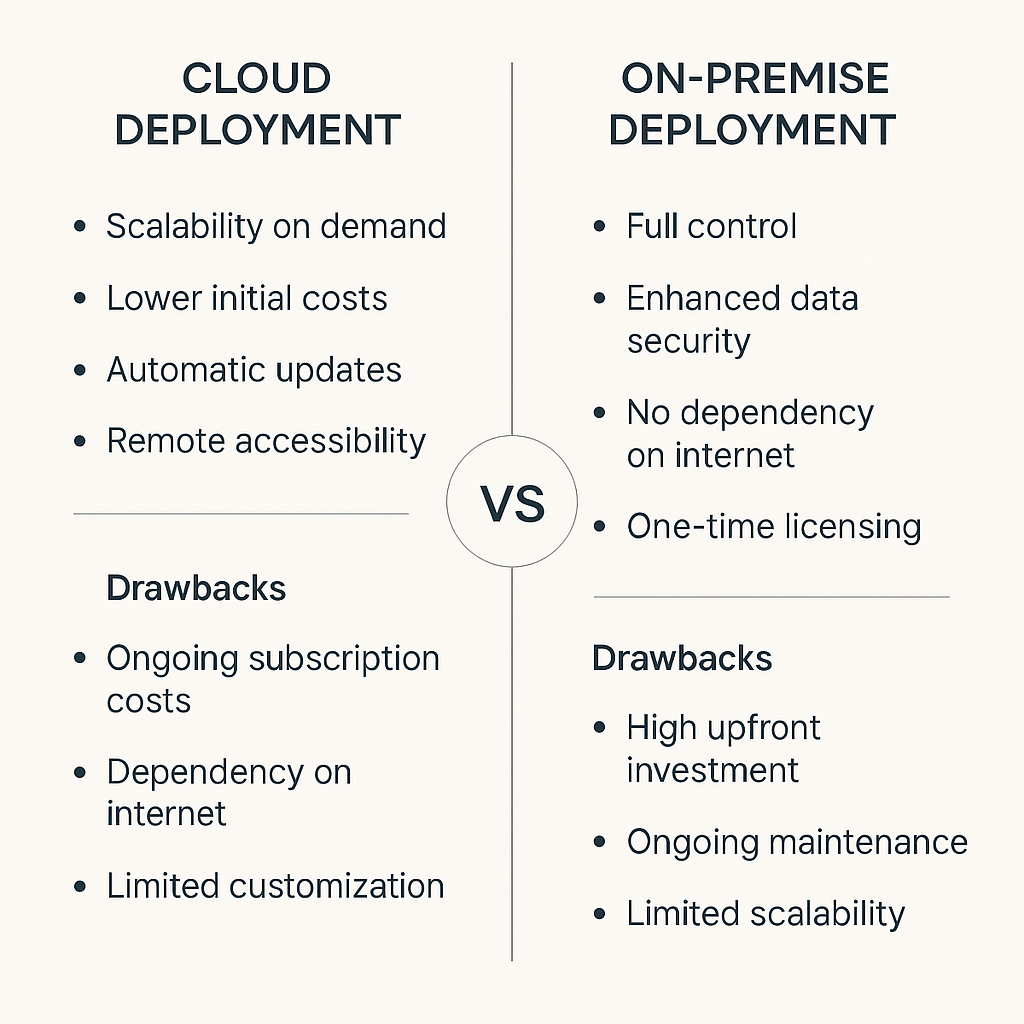
When businesses decide how to host their software, applications, or data, the two most common approaches are cloud-based deployment and on-premise deployment. Each option has distinct advantages and limitations, and the right choice often depends on a company’s priorities, resources, and growth strategy.
Cloud Deployment
In a cloud environment, the infrastructure is hosted and maintained by a third-party provider and accessed via the internet. Businesses pay a subscription fee for usage, and the provider takes care of updates, security patches, and uptime management.
Advantages of Cloud Deployment
- Scalability on Demand – Easily add or reduce computing power or storage without major hardware investments.
- Lower Initial Costs – No need to purchase physical servers or set up a large IT infrastructure.
- Automatic Updates – New features and security enhancements are deployed automatically without manual intervention.
- Remote Accessibility – Employees can access systems from anywhere with an internet connection.
Drawbacks of Cloud Deployment
- Ongoing Subscription Costs – Over time, recurring fees can exceed the one-time cost of buying infrastructure.
- Dependency on Internet – Performance and access are tied to the stability of your connection.
- Limited Customization – Certain solutions may restrict deep configuration compared to on-prem setups.
On-Premise Deployment
With an on-premise model, the company owns, installs, and operates its own servers and related hardware on-site. Software is installed locally, and the internal IT team is responsible for management and maintenance.
Advantages of On-Premise Deployment
- Full Control – Businesses can configure, secure, and optimize systems exactly as they wish.
- Enhanced Data Security – Sensitive information can be kept entirely within the organization’s physical network.
- No Dependency on Internet – Internal systems can function even during outages.
- One-Time Licensing – In some cases, a single payment covers the software license indefinitely.
Drawbacks of On-Premise Deployment
- High Upfront Investment – Requires purchasing servers, storage devices, networking gear, and backup systems.
- Ongoing Maintenance – Hardware upgrades, security patches, and troubleshooting fall entirely on the IT team.
- Limited Scalability – Expanding capacity can require significant new investments in equipment.

Cloud vs On-Premise: Key Differences
| Factor | Cloud | On-Premise |
| Cost | Pay-as-you-go | Large upfront investment |
| Scalability | Instant, on-demand | Limited by hardware capacity |
| Security | Provider-managed | Business-controlled |
| Maintenance | Vendor responsibility | In-house IT team |
| Accessibility | Anywhere with internet | Local network only |
Factors to Consider Before Deciding
- Budget: Can you afford a large upfront cost or prefer monthly payments?
- Security Requirements: Do you need in-house control or is vendor-level security enough?
- Workforce Location: Is your team remote or office-based?
- Growth Projections: Do you expect to scale rapidly?
- Industry Regulations: Are there compliance requirements for data storage?
Final Thoughts: Finding the Right Fit with Product Siddha
At the end of the day, choosing between cloud and on-premise deployment isn’t about which technology is “better” in a general sense; it’s about which is better for your specific business goals.
If your roadmap focuses on speed, flexibility, and the ability to scale without major upfront costs, the cloud can help you move faster and adapt to changing market demands. It’s especially valuable for remote teams, startups seeking agility, or companies launching products that may need rapid scaling.
On the other hand, if control, compliance, and long-term ownership are critical to your strategy, on-premise solutions can provide the confidence and security you need. This route is often preferred by industries with strict regulations, businesses with strong in-house IT teams, or organizations that handle highly sensitive data.
For many modern companies, the smartest choice may not be purely one or the other. A hybrid approach, blending the scalability of the cloud with the control of on-premise infrastructure, can deliver the best of both worlds, giving you flexibility without sacrificing security.
At Product Siddha, we help businesses navigate these decisions with clarity and confidence. Our experts work with you to design a deployment strategy that aligns with your vision, budget, and long-term growth plans — so your technology becomes a powerful driver of success, not a limitation.
